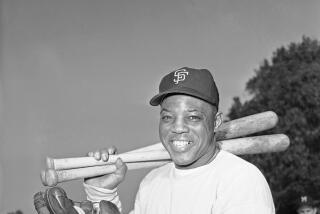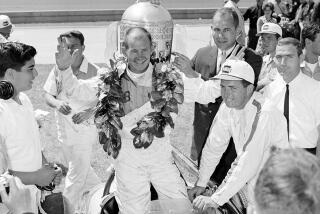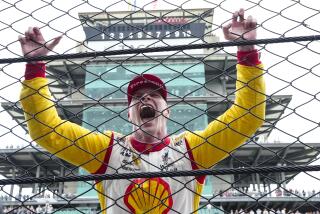Out of Gas : Injuries and Lack of Enthusiasm Led to the Surprising Retirement of Rick Mears
It took Richard Petty, 55, an entire year to retire. A.J. Foyt, 57, hasn’t figured out how to do it yet. Hershel McGriff, 64, doesn’t think he ever will.
Retiring is something with which race drivers, like many other sports personalities, have difficulty coping.
Which is one reason Rick Mears’ sudden announcement that he was retiring at 41--seemingly still in the prime of his driving career--so stunned the motor racing world, including his associates on Roger Penske’s team.
Mears had won four Indianapolis 500s and his record on the big ovals indicated that he was a cinch to break out of a tie with Foyt and Al Unser as the all-time winner of racing’s biggest prize. He was the No. 1 driver on the most successful team in the history of Indy car racing. He has won $4,299,000 at Indy alone, $11,050,000 in Indy cars.
“You hear a lot of drivers say they’ll quit when they’re not enjoying it, when they get up in the morning and don’t look forward to going to the track,” Mears said. “Well, that’s pretty much what happened to me. It was a combination of things, but mostly it was losing that enthusiasm I always felt before.”
Mears suffered two serious injuries at Indianapolis last May. The first occurred May 6, when his Penske-Chevy spun into the wall: a broken left foot and a sprained wrist. Then, during the race, he hit Jim Crawford’s spinning car and aggravated the wrist injury.
The wrist injury turned out to be more serious than was first thought, and Mears turned his seat over to the young Canadian, Paul Tracy, after trying to run in the Marlboro 500 at Michigan International Speedway on Aug. 2.
“What happened at Indy probably speeded up the process, but I had started thinking about getting out of the car even before we went to Australia for the first race last season,” Mears said. “It’s hard to put a finger on when I started thinking about it, it just sort of crept up on me. But I had always told myself, if it got to this point, I was going to get out.”
No one but Mears’ wife, Chris, and his boss, Penske, knew beforehand that he was going to make his announcement during the Penske team’s Christmas party in Reading, Pa., on Dec. 10.
“It was the toughest thing I’ve ever had to do in my life,” Mears said. “I really had to struggle to get it out and you could have heard a pin drop when I finished. I felt the Christmas party was the perfect time--all the team was there and all the sponsors. I felt I owed it to them to let them know first and not to hear it from someone else first.
“Roger always says a few words, thanking everyone, and then the drivers each get up and say a few words, so no one suspected anything. In fact, that day I had spent hanging around the race shop, talking with all the guys about how I was looking forward to next year, how the wrist felt good and I was anxious to get back in the car.
“I knew I was lying, but it was the only way I could wait to tell everyone at once.”
Emerson Fittipaldi, who has been Mears’ teammate for the last three seasons, said he was shocked.
“I had been with Rick at Indianapolis a month before and he said the wrist was coming along fine and he couldn’t wait to start testing the new car,” Fittipaldi said from Phoenix, where he and Tracy tested the 1993 car earlier this week. “Just before the announcement, I was telling Teresa (Fittipaldi’s wife) that I thought he would drive for two more years.
“When I saw Rick in England after the announcement, I asked him why he retired and he told me that he just didn’t have the motivation, the fire. For sure, I understand. It was a great loss for us. He was a great champion, an incredible driver, and we had a great relationship.”
His teammates should have been prepared for something, however, when Mears showed up with a neatly trimmed beard.
“It’s something I grew while I was down in Mexico, helping Roger (his brother) get ready for the Baja 1000. I guess I felt I needed a personality change,” he said with a smile.
Mears will not be away from racing, only away from the driver’s seat. He has committed to being at every race, helping with team strategy, and coaching Tracy, the latest Penske protege.
“I still enjoy the sport, just not the driving part of it,” he said. “I told Roger (Penske) I would do anything he wanted me to do, except get in the car and drive. Next year will be a learning curve for me, but I am looking forward to it with a different kind of enthusiasm.
“I am looking forward to working with Tracy. I know when I was young and inexperienced, I appreciated it when a veteran driver helped me. Last year, when I saw several ways in which I could help Paul, I told him, and he responded very favorably.”
Tracy, who turned 24 Thursday, did well as Mears’ replacement last season. He finished a close second to fellow Canadian Scott Goodyear at Michigan and was second again at Mid-Ohio. He also was fastest qualifier at Road America.
Penske, who plucked Mears from the obscurity of desert off-road races to drive one of his Indy cars in 1978, said he respected Mears’ decision.
“Over time, Rick will be remembered as the ultimate team player who never lost his perspective from the day he walked in the door back in 1978,” Penske said. “Rick’s peers held him in the highest regard, as not only a great race driver, but one of the sport’s true gentlemen.
“I am pleased that he will continue with the team and contribute his extensive experience to our program.”
Mears was an immediate success with Penske. In his first season, he qualified in the front row at Indy and was voted co-rookie of the year. Later, he won races at Milwaukee, Atlanta and Brands Hatch, England.
In 1979, he won the first of his four Indy 500s and the first of his three PPG Cup Indy car championships. He also won at Indy in 1984, 1988 and 1991 and won the championship in 1981 and 1982.
After displaying his talents at driving 220 m.p.h. on the big oval at Indianapolis, Mears shocked veteran Indy car followers when he said what helped him most was the experience he gained racing across the desert in the Baja 1000 and other off-road races.
“I learned early on out in the desert that you had to keep your car running in order to win,” he said. “A lot of drivers think they have to get in the lead and stay there, but it doesn’t bother me at all to drop back, conserve my engine and my car, and then be ready to make a move late in the race. I’ve done it many times in the desert, and it’s a theory that works at Indy, too.”
His trademark was to go fast in qualifying--he won a record six poles at Indy--start up front and then drop back while he got his car and his competitors sorted out. Then, when the race for the finish line started, Mears usually had his car in perfect balance, ready to charge.
Reminiscing, Mears pinpointed his fourth Indy 500 victory, two years ago, as the most memorable.
“It was a special year for me, running in Marlboro’s colors for the first time after being with Pennzoil for so long, and there was all the hoopla of the 75th anniversary and it being A.J. Foyt’s last race--so he said at the time. And to be on the pole with two of my idols, A.J. and Mario Andretti, alongside me on the front row, was a tremendous feeling.
“Then the race went almost exactly the way I’ve always tried to strategize it. The same situation almost happened in ’84 with Tom Sneva, but then he had a problem and we didn’t have the shootout at the end. But in ‘91, that’s the way I always tried to plan races, working with the car throughout the race and holding a little back so in the final laps you can be the fastest car and win, and this one just worked the way I always tried to make it happen. That made it a very gratifying win.
“One of the other ways I always wanted to win was by taking the lead on the last lap, and that happened one year in Michigan when I passed Mario on the last lap. That was a real thrill to pass someone of Mario’s talent and experience on the final lap. Obviously, there were a lot of great wins but those two stand out in my mind as two of the most satisfying.”
Even before his injuries this year, Mears learned the downside of racing. There was the pit fire in 1981 that left him with facial burns and the crash at Sanair, Canada, in 1984, when his car slid underneath a guardrail and crushed his feet and ankles.
“Sure, I came back after both those accidents, but at the end they were one of the things I considered,” he said. “You know, I’m reminded of them every day when I get up in the morning--the first 10 steps are a killer.”
Mears said his wife never tried to influence him one way or the other about quitting. She was the one who helped nurse him back to health in 1984, before they were married.
“She saw racing from both ends of the spectrum early on,” he said. “We’d only been going together about a year and she’d seen me win Indy and then have the crash in Canada, but never at any time, never ever, did she make the slightest remark about my not staying in racing. The decision to get out was mine, and mine alone.”
The Mearses now live in Jupiter, Fla., having sold their home in Bakersfield last year.
“We found ourselves spending all of our free time there, enjoying the water and our boats so much that we decided to make it permanent,” he said.
Mears actually got his start racing sprint cars with his brother Roger at Ascot Park in the early 1970s. Rick won the track championship in 1971.
“Maybe where I learned to drive fast was hauling the buggy over the Ridge from Bakersfield every week to run at Ascot,” he said, laughing. “There were lots of times we’d be working so late on the buggy that we’d barely have time to get to Gardena before they closed the back gate. To tell the truth, we didn’t have enough time, but somehow we made it.”
In 1976, safety equipment manufacturer Bill Simpson gave him a ride in an Indy car. His first race was the California 500 at Ontario Motor Speedway, where he finished eighth. That, and a ninth at Texas World Speedway, earned him U.S. Auto Club rookie-of-the-year honors.
Between the 1977 and 1978 seasons, Mears and Penske happened to be on the same motorcycle run in Colorado when Penske invited Mears to drop around to his office later in the month to talk about driving his Indy car when his regular driver, Mario Andretti, was unavailable because of Formula One commitments.
“Rick was there before we opened the doors,” Penske recalled recently. “And he’s never changed. He’s always there when something needs to be done.”
One thing Mears will not do, he said, is test-drive the Penske cars.
“If I drove as much as one lap testing, I might as well be back in the car full time,” he said. “I think sitting out those races last year gave me a lot of time to think. I caught myself enjoying it, working with Emerson and Paul, and not really missing being in the car. That was an indication that I didn’t need to be out there.
“I wanted to make sure I wouldn’t have any second thoughts, and I’m sure I won’t have.”
More to Read
Go beyond the scoreboard
Get the latest on L.A.'s teams in the daily Sports Report newsletter.
You may occasionally receive promotional content from the Los Angeles Times.










